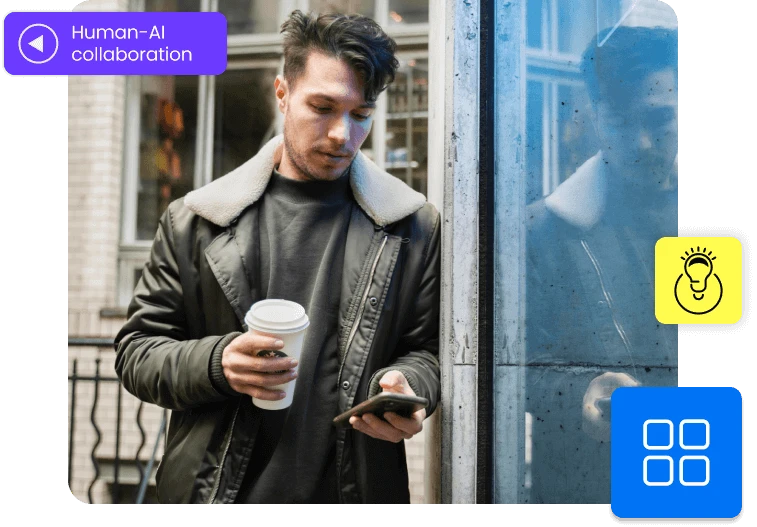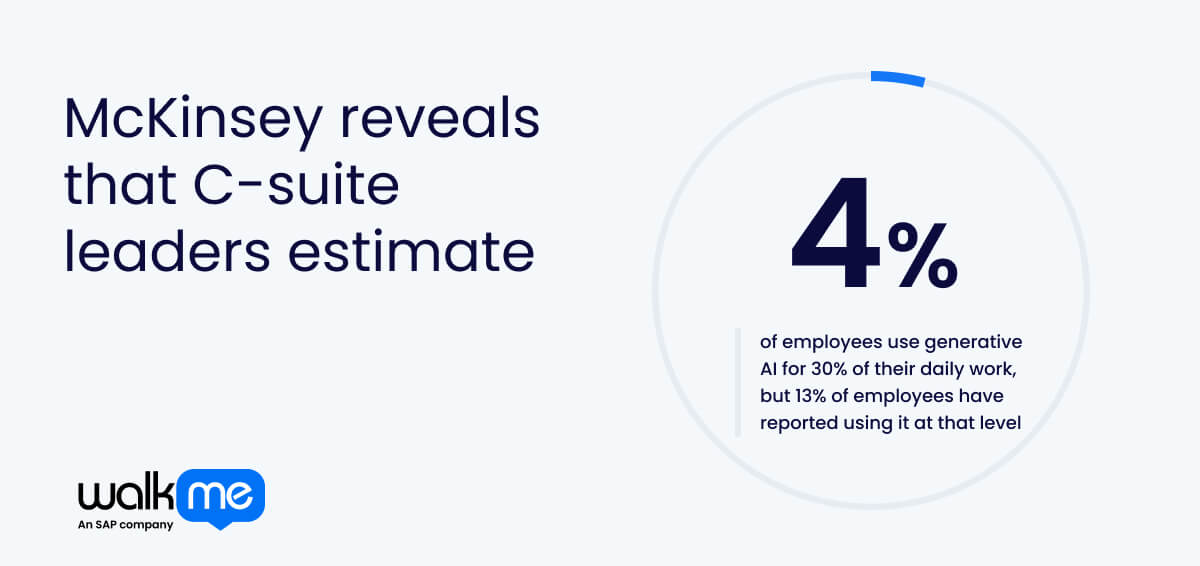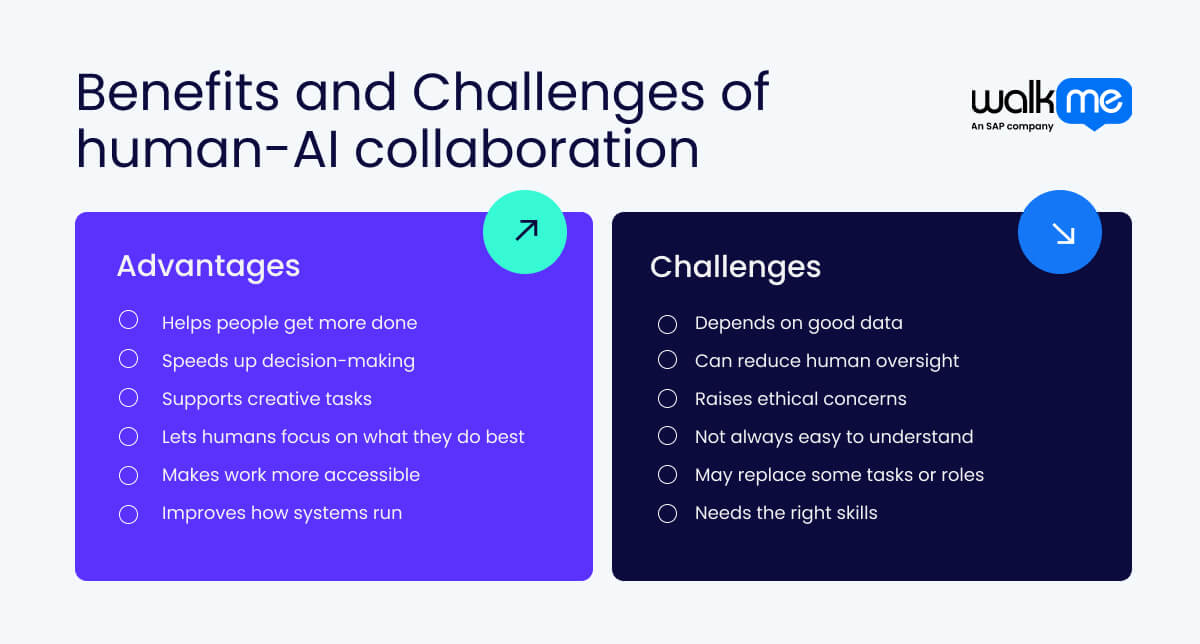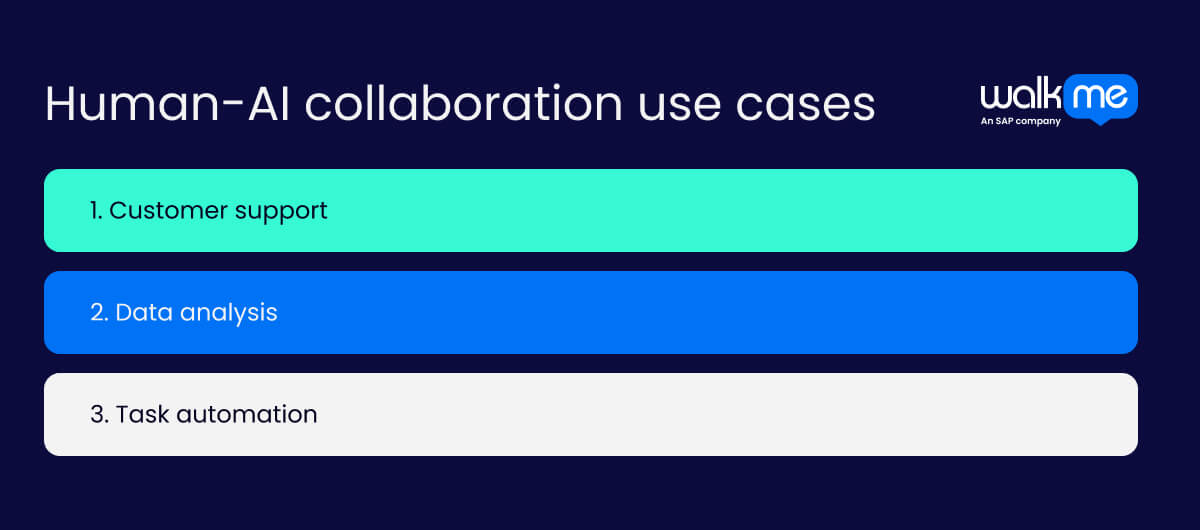What is human-AI collaboration?
Human-AI collaboration is when people work alongside artificial intelligence systems to complete tasks more effectively.

Table of contents
Such partnerships are becoming more common in areas such as writing, design, coding, and customer support. Tools like ChatGPT, DALL-E, and GitHub Copilot are generative AI systems that are available to help people augment their day-to-day tasks with AI-powered skills.
Instead of replacing humans, AI acts as a partner that provides speed and automation, alongside specific capabilities such as handling large volumes of data or analyzing it to provide insights. Humans bring creativity, contextual analysis, judgment, and emotional insight to the table, which leads to better results than either could achieve alone.
The practice is growing rapidly, and is happening more than senior leadership realizes. For example, McKinsey reveals that C-suite leaders estimate 4% of employees use generative AI for 30% of their daily work, but 13% of employees have reported using it at that level.

Why is human-AI collaboration important?
When humans collaborate with AI and create solutions that exceed what was previously possible, it represents a move towards augmented intelligence. In other words, technology is used to support human decision-making and enhance their lives.
In a business setting, human-AI collaboration can improve decision-making and scale work without concerns about quality being sacrificed. As AI is being harnessed as Technology as a Teammate, humans remain in the loop to govern and augment their outputs.
Effectively, the partnership helps teams move faster while they maintain control. Workplaces can automate routine tasks, such as data entry or customer queries, freeing up people’s time to solve complex problems and guide strategy.
Businesses are rapidly recognizing the benefits of human-AI collaboration. 78% of McKinsey survey respondents say their organizations use AI in at least one business function, indicating how the partnership is being leveraged for success.

What are the benefits of human-AI collaboration?
Human-AI collaboration isn’t just about saving time; it’s about working more smartly. When people and AI tools form a partnership, tasks become easier, ideas come more quickly, and results often improve.
Below are some of the key benefits that come from collaborating with artificial intelligence:
- Helps people get more done: AI takes care of repetitive tasks, so humans can spend more time on important or creative work.
- Speeds up decision-making: It quickly finds patterns in data, giving people the information they need to make quicker decisions
- Supports creative tasks: AI tools suggest ideas, drafts, or designs that humans can shape into final pieces.
- Lets humans focus on what they do best: With AI handling routine work, people can focus on problem-solving, communication, and empathy.
- Makes work more accessible: Tools like translation and voice-to-text help more people engage in human-AI collaboration, regardless of their language or ability.
- Improves how systems run: In factories or offices, AI can spot issues early and help things run more smoothly.
To realize these benefits fully, many organizations roll out a Digital Adoption Platform (DAP). The tool helps employees learn how to work well with AI tools with guided workflows and tailored assistance while they complete tasks.
What are the challenges of human-AI collaboration?
While the benefits are clear, working with AI isn’t always straightforward. As this type of collaboration grows, so do the risks and limitations that come with it.
Below are some of the key challenges to be aware of.
- Depends on good data: AI tools need large amounts of high-quality data to work well. If the data is biased or incomplete, the results can be misleading.
- Can reduce human oversight: When people rely too heavily on AI, they may overlook errors or miss opportunities to question suggestions.
- Raises ethical concerns: Decisions made with AI – especially in sensitive areas like hiring or healthcare – can raise fairness and transparency issues.
- Not always easy to understand: Some AI systems work in ways that are difficult to explain, making it hard for users to trust or verify the results.
- May replace some tasks or roles: In certain industries, AI can automate jobs that used to be done by people, leading to concerns about job loss.
- Needs the right skills: Teams need to learn how to use AI tools effectively, which can take time, training, and ongoing support.
Human-AI collaboration use cases

Human-AI collaboration is becoming increasingly commonplace, particularly in the workplace. While it certainly saves time and reduces effort, it also enables people to excel in their roles by combining their knowledge with AI’s capabilities.
Customer support
In customer support, contextual AI chatbots are capable of handling simple queries around the clock. Not only does it mean customers don’t have to wait as long for the answers they need, but it also frees up human agents to handle more complex situations. When customers need a focus on sophisticated problem-solving and empathy, real people are available to help them out.
Data analysis
Meanwhile, in data analysis, AI systems process huge amounts of information and surface trends in a fraction of the time it would take humans. Moreover, AI takes these trends a step further by creating visual dashboards and alerts to initiate the interpretation process. That’s where analysts and decision-makers step in to make sense of the results and shape their actions to align with business goals.
Task automation
AI tools can easily manage calendar scheduling and triage emails. Purely operationally, they are also capable of triggering workflows when particular rules are set. This operational use case translates to factory floors, where robotic systems use AI to carry out precise repetitive movements. Humans are still involved, though, as they monitor the process and troubleshoot any issues. They also adjust situations if there are changes in conditions.